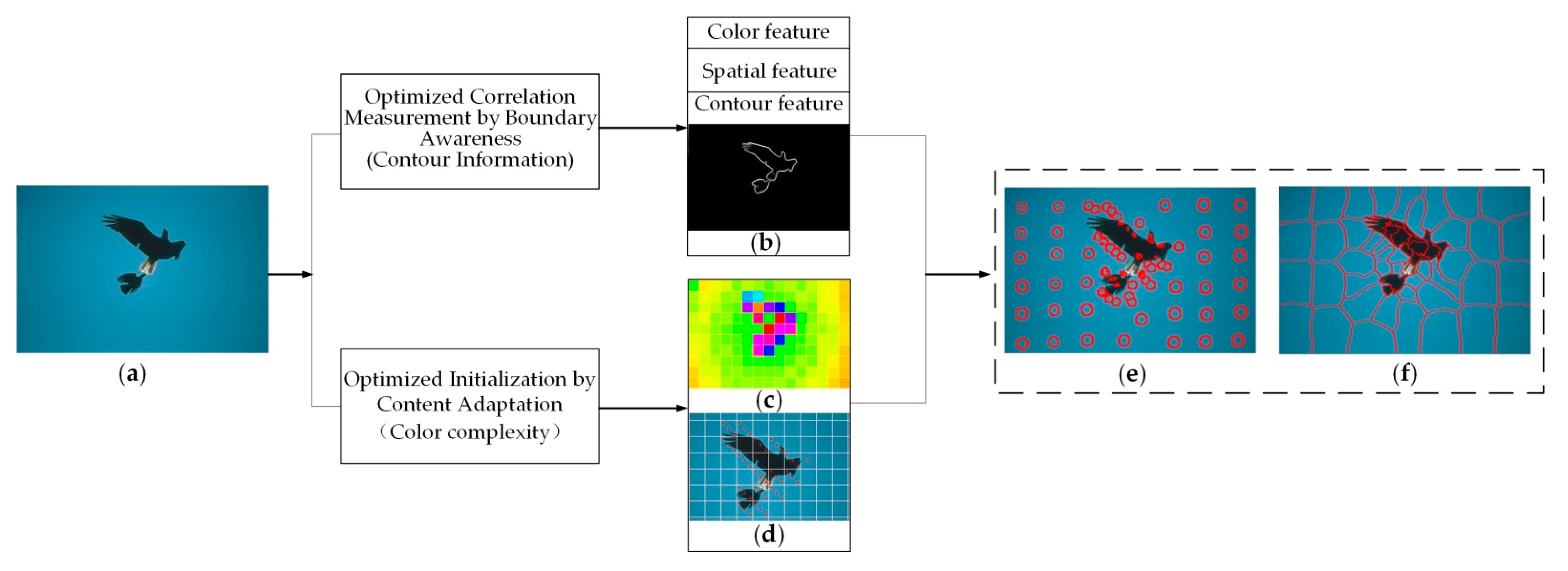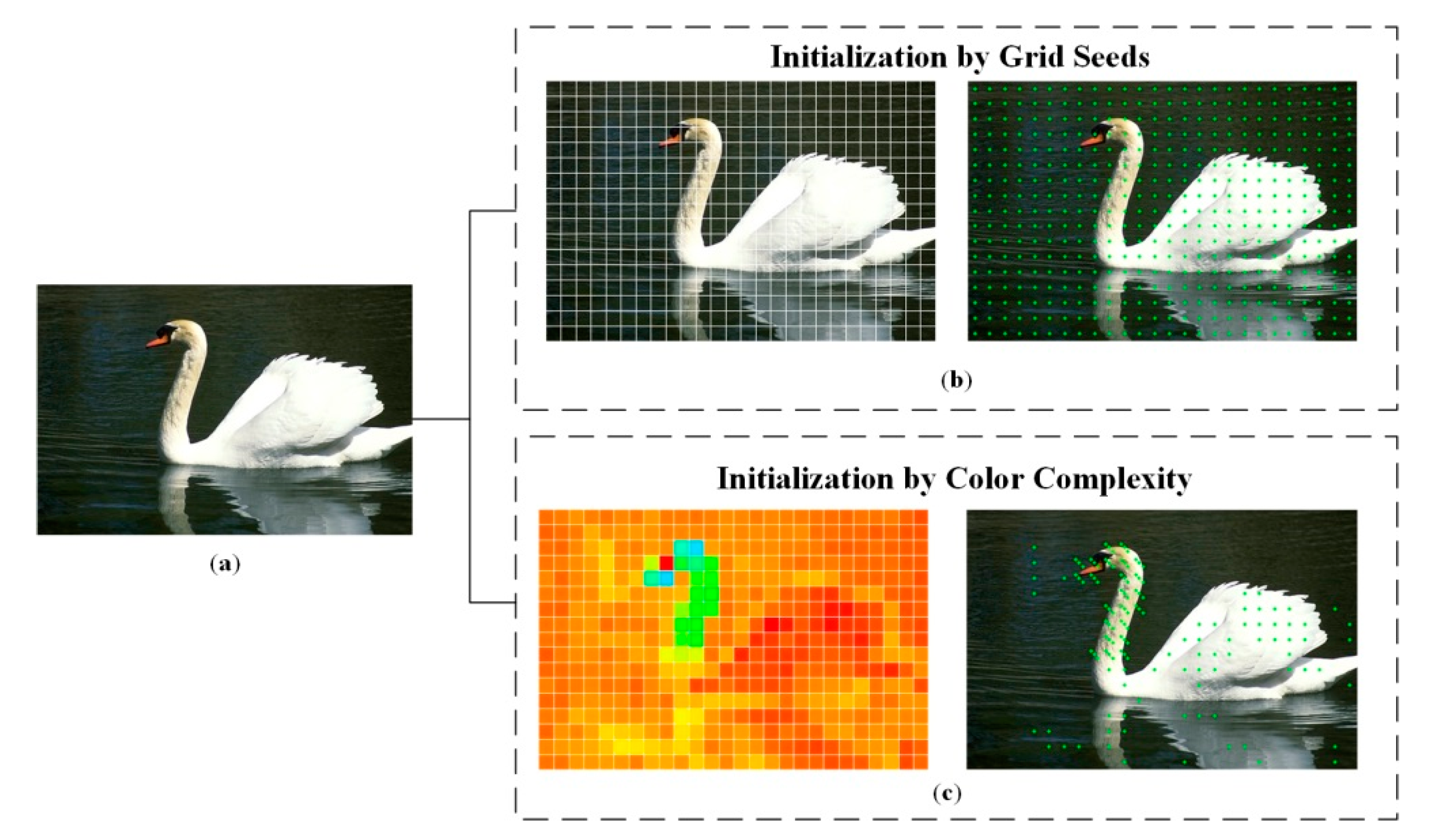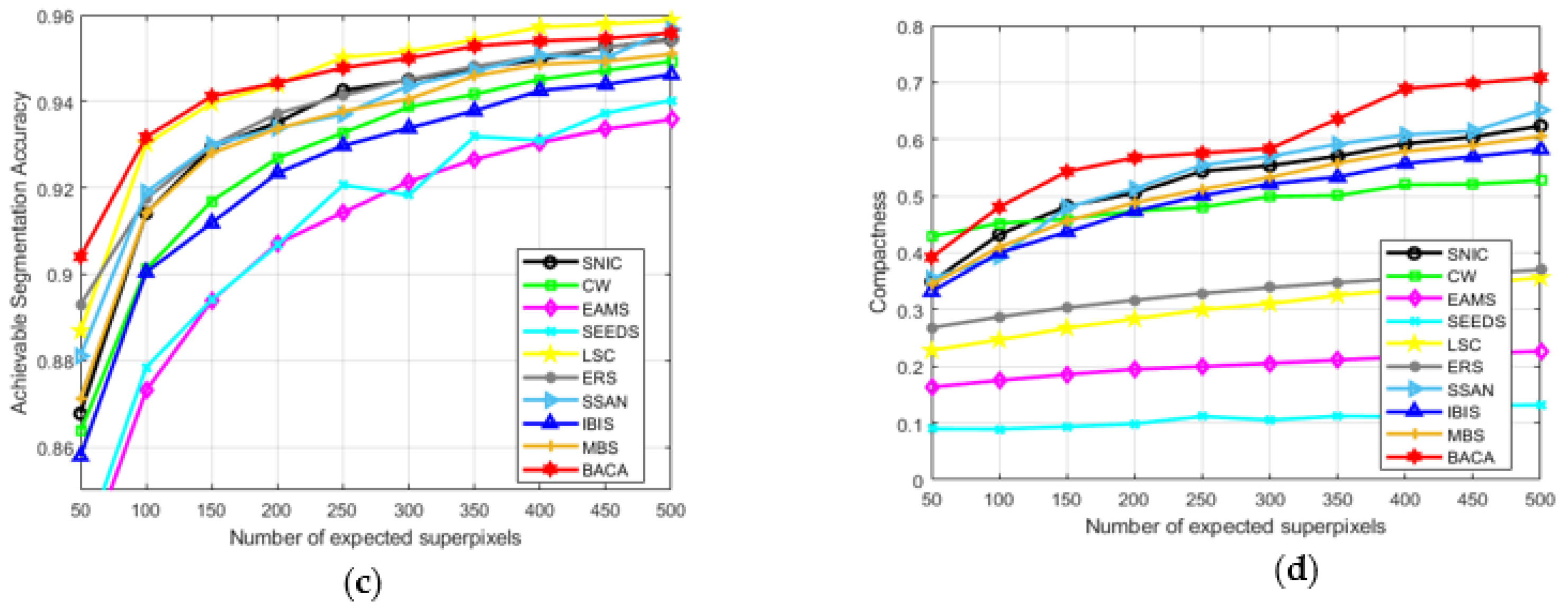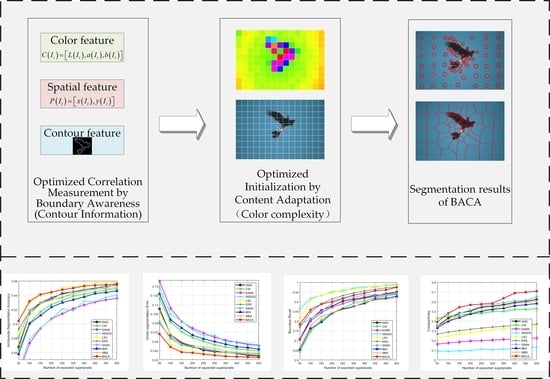BACA: Superpixel Segmentation with Boundary Awareness and Content Adaptation
Abstract
:1. Introduction
- (1)
- An adaptive seed sampling method based on content complexity is proposed in the initialization stage, which can effectively reduce the computational cost and lays a good foundation for the subsequent steps of the superpixel algorithm.
- (2)
- A new correlation distance measurement method integrating boundary perception and contour prior is proposed. It also overcomes the limitation of multiple calculations, further facilitating the generation of more accurate superpixels.
- (3)
- It objectively and truly proves the feasibility of the above two points from both quantitative and qualitative aspects and compares it with the current nine excellent algorithms [19,21,22,23,24,25,26,27,28]. Experimental results further verify that BACA’s segmentation results are uniform, accurate and effective.
2. Backgrounds
- Accuracy-oriented. Linear Spectral Clustering (LSC) [21] designs an approximate correlation measurement that maps pixels to a ten-dimensional feature space and then uses weighted K-means clustering to generate superpixels. It has a good output effect, but the running speed of the algorithm is slow. Entropy Rate Superpixel (ERS) [22] generates superpixels by solving the extremum of the objective function. The two terms of the objective function affect the compactness and regularity of superpixels, respectively. Therefore, the output results of this algorithm have a good boundary fit.
- Efficiency-oriented. Compact Watershed (CW) [23] is an extremely efficient superpixel generating algorithm based on the marker-controlled watershed transformation. It introduces spatial constraint into the gradient-based region-growing framework, thus producing a uniform appearance with desirable segmentation quality. Superpixels extracted via energy-driven sampling (SEEDS) [24] starts from a regular grid, and then refines superpixels by constantly modifying the boundary. During the iterations, it adopts hill-climbing to solve the maximized energy cost function. In 2021, Serge Bobbia et al. proposed the Iterative Boundaries Implicit Identification (IBIS) [25] algorithm, which uses only a fraction of pixels in the image and implicitly identifies superpixel boundaries, significantly improving the computational efficiency. Xia Ren et al. proposed Structure-sensitive Superpixel Algorithm based on Non-iteration (SSAN) [26]. By using the priority queue structure to extend the pixel label and designing a new centroid splitting and merging operator according to the manifold space area element, the structure-sensitive superpixels are quickly generated.
- Balance-oriented. Achanta et al. put forward the epoch-making Simple Linear Clustering (SLIC) [20] and then updated it to Simple Non-Iterative Clustering (SNIC) [19]. Compared with the conventional K-means clustering method, it restricts the searching range and proposes a novel color-spatial distance measurement from seed points. Nevertheless, it does not consider the global information of the image due to its simplicity. In the subsequent SNIC, the iterative clustering framework is substituted by a non-iterative implementation. The optimized algorithm could execute in a single loop with better region connectivity, less memory and faster speed. Moreover, Edge Augmented Mean Shift (EAMS) [27] could search for patterns according to the density in the image, which proves sufficient boundary compliance for superpixel generation from the perspective of density estimation. Minimum Barrier Distance for Superpixel Segmentation (MBS) [28] was published in 2018 to provide a propagation scheme for clustering centers between adjacent levels on a hierarchical architecture, which makes a simple trade-off between performance and efficiency.
| Algorithm 1. SNIC segmentation algorithm |
| Input: the RGB image , the total number of pixels , the expected number , compactness |
| Output: Assigned label map |
| /*Initialization*/ |
| Initialize the label map divided the whole image into grids Convert image from RGB space to CIELAB space /*Joint assignment and updating*/ The centers of grids are taken as the initial clustering centers |
| do element |
| Push element into priority queue |
| end for |
| is not empty do |
| Pop the top element of priority queue Update clustering center of all region |
| then |
| for Pop four or eight neighborhood pixels of the pixel do |
| Calculate the distance between pop pixel and clustering center |
| then |
| Push element into priority queue |
| end if |
| end for end if end while |
| return Assigned label map |
3. Our Approach
3.1. Optimized Initialization by Complexity
- If the color richness of the current grid , the current grid is defined as the content simple region;
- If the color richness of the current grid , the current grid is defined as the content of the general complex region;
- If the color richness of the current grid , the current grid is defined as the content complex region.
| Algorithm 2. Seed initialization |
| Input: the RGB image , the expected number |
| Output: coordinates of seeds |
| /*Initialization*/ |
| divided the whole image into grids |
| calculate the colorfulness of the image by Equation (3). |
| for each cluster region do |
| calculate the colorfulness of cluster region by Equation (2). |
| end for |
| calculate the mean value of all |
| for each cluster region do |
| If then |
| place three seeds evenly diagonally on cluster region |
| else if then |
| place a seed in the cluster region center |
| else threshold |
| place a seed in the cluster region center |
| end if |
| end for |
| return coordinates of seeds |
3.2. Optimized Correlation Measurement
4. Experiment and Discussion
4.1. Experiment Setup
4.2. Algorithm Analysis
4.2.1. Visual Comparisons of Superpixel Results
4.2.2. Quantitative Evaluation by Metrics
- Boundary Recall (BR). BR is a popular metric to describe the fit degree between the superpixel outlines and the object boundaries. A greater BR indicates that the superpixel boundary is closer to the real boundary of the image.
- Under-segmentation Error (UE). UE measures a ratio of the spilled pixels to the real segmented pixels, wherein the former refers to the pixels beyond the intersection of the superpixel and the ground truth. It is negatively correlated with segmentation accuracy.
- Achievable Segmentation Accuracy (ASA). ASA describes the accuracy of segmentation results. It reveals the percentage of the correct segmentation in terms of the ground truth.
- Compactness (CO). CO describes the roundness of each superpixel block, which is positively associated with the regularity and uniformity of the superpixel shape.
4.2.3. Ablation Experiments
4.3. More Discussion
5. Conclusions
Author Contributions
Funding
Institutional Review Board Statement
Informed Consent Statement
Data Availability Statement
Acknowledgments
Conflicts of Interest
References
- Ren, X.; Malik, J. Learning a classification model for segmentation. In Proceedings of the IEEE International Conference on Computer Vision (ICCV), Nice, France, 13–16 October 2003; pp. 10–17. [Google Scholar]
- Hsu, C.; Hsieh, Y.; Lo, K.; Chuang, J. Incorporating texture information into region-based unsupervised image segmentation using textural superpixels. In Proceedings of the IEEE International Conference on Image Processing (ICIP), Paris, France, 27–30 October 2014; pp. 4323–4327. [Google Scholar]
- Yang, F.; Sun, Q.; Jin, H.; Zhou, Z. Superpixel segmentation with fully convolutional networks. In Proceedings of the Computer Vision and Pattern Recognition (CVPR), Seattle, WA, USA, 13–19 June 2020; pp. 13961–13970. [Google Scholar]
- Xiao, X.; Gong, Y.; Zhou, Y. Adaptive superpixel segmentation aggregating local contour and texture features. In Proceedings of the IEEE International Conference on Acoustics, Speech and Signal Processing (ICASSP), New Orleans, LA, USA, 5–9 March 2017; pp. 1902–1906. [Google Scholar]
- Giraud, R.; Ta, V.; Papadakis, N. Robust superpixels using color and contour features along linear path. Comput. Vis. Image Underst. 2018, 170, 1–13. [Google Scholar] [CrossRef]
- Giraud, R.; Ta, V.; Papadakis, N. Superpixel-based Color Transfer. In Proceedings of the IEEE International Conference on Image Processing (ICIP), Beijing, China, 17–20 September 2017; pp. 700–704. [Google Scholar]
- Li, C.; Guo, B.; Liao, N.; Gong, J.; He, W. CONIC: Contour Optimized Non-Iterative Clustering Superpixel Segmentation. Remote Sens. 2021, 13, 1061. [Google Scholar] [CrossRef]
- Arisoy, S.; Kayabol, K. Mixture-based superpixel segmentation and classification of SAR image. IEEE Geosci. Remote Sens. Lett. 2016, 13, 1721–1725. [Google Scholar] [CrossRef]
- Liu, J.; Yang, W.; Sun, X.; Zeng, W. Photo stylistic brush: Robust style transfer via superpixel-based bipartite graph. IEEE Trans. Multimed. 2017, 20, 1724–1737. [Google Scholar] [CrossRef]
- Barnes, C.; Shechtman, E.; Finkelstein, A.; Goldman, D.B. PatchMatch: A randomized correspondence algorithm for structural image editing. ACM Trans. Graph. 2009, 28, 24. [Google Scholar] [CrossRef]
- Xing, F.; Cambria, E.; Huang, W.; Xu, Y. Weakly supervised semantic segmentation with superpixel embedding. In Proceedings of the IEEE International Conference on Image Processing (ICIP), Phoenix, AZ, USA, 25–28 September 2016; pp. 1269–1273. [Google Scholar]
- Zhang, G.; Jia, X.; Hu, J. Superpixel-Based Graphical Model for Remote Sensing Image Mapping. IEEE Trans. Geosci. Remote Sens. 2015, 53, 5861–5871. [Google Scholar] [CrossRef]
- Yang, F.; Lu, H.; Yang, M. Robust Superpixel Tracking. IEEE Trans. Image Process. 2014, 23, 1639–1651. [Google Scholar] [CrossRef]
- Brian, F.; Andrea, V.; Soatto, S. Class segmentation and object localization with superpixel neighborhoods. In Proceedings of the 2009 IEEE 12th International Conference on Computer Vision (ICCV), Kyoto, Japan, 29 September–2 October 2009; pp. 670–677. [Google Scholar]
- Arivazhagan, S.; Lilly Jebarani, W.; Newlin Shebiah, R.; Vineth Ligi, S.; Hareesh Kumar, P.V.; Anilkumar, K. Significance based Ship Detection from SAR Imagery. In Proceedings of the International Conference on Innovations in Information and Communication Technology (ICIICT), Chennai, India, 25–26 April 2019; pp. 1–5. [Google Scholar]
- Yuan, D.; Liu, C.; Zhang, H. Superpixel-Based Depth Estimation for Multiple View Stereo. In Proceedings of the IEEE International Conference on Real-Time Computing and Robotics (RCAR), Kandima, Maldives, 1–5 August 2018; pp. 645–650. [Google Scholar]
- Jin, F.; Li, X. A dense depth estimation method using superpixels. In Proceedings of the IEEE International Conference on International Computer Conference on Wavelet Active Media Technology and Information Processing (ICCWAMTIP), Chengdu, China, 18–20 December 2015; pp. 290–294. [Google Scholar]
- Lien, C.; Yu, K.; Hsieh, C.; Chen, Y.; Wang, C. Blur image segmentation using iterative superpixels grouping method. In Proceedings of the International Conference on Machine Learning and Cybernetics, Tianjin, China, 14–17 July 2013; pp. 1161–1167. [Google Scholar]
- Achanta, R.; Susstrunk, S. Superpixels and polygons using simple non-iterative clustering. In Proceedings of the IEEE Conference on Computer Vision and Pattern Recognition (CVPR), Honolulu, HI, USA, 21–26 July 2017; pp. 4895–4904. [Google Scholar]
- Achanta, R.; Shaji, A.; Smith, K.; Lucchi, A.; Fua, P.; Susstrunk, S. SLIC superpixels compared to state-of-the-art superpixel methods. IEEE Trans. Pattern Anal. Mach. Intell. 2012, 34, 2274–2282. [Google Scholar] [CrossRef]
- Chen, J.; Li, Z.; Huang, B. Linear spectral clustering superpixel. IEEE Trans. Image Process. 2017, 26, 3317–3330. [Google Scholar] [CrossRef]
- Liu, M.; Tuzel, O.; Ramalingam, S.; Chellappa, R. Entropy rate superpixel segmentation. In Proceedings of the IEEE Conference on Computer Vision and Pattern Recognition (CVPR), Colorado Springs, CO, USA, 20–25 June 2011; pp. 2097–2104. [Google Scholar]
- Neubert, P.; Protzel, P. Compact Watershed and Preemptive SLIC: On improving trade-offs of superpixel segmentation algorithms. In Proceedings of the IEEE International Conference on Pattern Recognition (ICPR), Stockholm, Sweden, 24–28 August 2014; pp. 996–1001. [Google Scholar]
- Van den Bergh, M.; Boix, X.; Roig, G.; Van Gool, L. SEEDS: Superpixels extracted via energy-driven sampling. Int. J. Comput. Vis. 2015, 111, 298–314. [Google Scholar] [CrossRef]
- Bobbia, S.; Macwan, R.; Benezeth, Y. Iterative Boundaries implicit Identification for superpixels Segmentation: A real-time approach. IEEE Access 2021, 9, 77250–77263. [Google Scholar] [CrossRef]
- Ren, X. Research on Visual Analysis Method and Application of Natural Image Based on Superpixel. Degree of Master, Xidian University, Xi’an, China, June 2022. [Google Scholar]
- Comaniciu, D.; Meer, P. Mean shift: A robust approach toward feature space analysis. IEEE Trans. Pattern Anal. Mach. Intell. 2002, 24, 603–609. [Google Scholar] [CrossRef]
- Hu, Y.; Li, Y.; Song, R.; Rao, P.; Wang, Y. Minimum barrier superpixel segmentation. Image Vis. Comput. 2018, 70, 1–10. [Google Scholar] [CrossRef]
- Yang, S.; Yuan, X.; Liu, X.; Chen, Q. Superpixel generation for polarimetric SAR using hierarchical energy maximization. Comput. Geosci. 2020, 135, 104395. [Google Scholar] [CrossRef]
- Liu, Y.; Yu, M.; Li, B.; He, Y. Intrinsic manifold SLIC: A simple and efficient method for computing content-sensitive superpixels. IEEE Trans. Pattern Anal. Mach. Intell. 2018, 40, 653–666. [Google Scholar] [CrossRef] [PubMed]
- Kang, X.; Zhu, L.; Ming, A. Dynamic random walk for superpixel segmentation. IEEE Trans. Image Process. 2020, 29, 3871–3884. [Google Scholar]
- Zou, H.; Qin, X.; Zhou, S.; Ji, K. A likelihood-based SLIC superpixel algorithm for SAR images using generalized gamma distribution. Sensors 2016, 16, 1107. [Google Scholar]
- Lv, N.; Chen, C.; Qiu, T.; Sangaiah, A.K. Deep learning and superpixel feature extraction based on contractive autoencoder for change detection in SAR images. IEEE Trans. Ind. Inform. 2018, 14, 5530–5538. [Google Scholar] [CrossRef]
- Li, C.; Guo, B.; Wang, G.; Zheng, Y.; Liu, Y.; He, W. NICE: Superpixel segmentation using non-iterative clustering with efficiency. Appl. Sci. 2020, 10, 4415. [Google Scholar] [CrossRef]
- Li, C.; Guo, B.; Huang, Z.; Gong, J.; Han, X.; He, W. GRID: GRID Resample by Information Distribution. Symmetry 2020, 12, 1417. [Google Scholar] [CrossRef]
- Achanta, R.; Marquez, P.; Fua, P.; Susstrunk, S. Scale-adaptive superpixels. In Proceedings of the IS&T Color and Imaging Conference (CIC), Vancouver, BC, Canada, 12–16 November 2018; pp. 1–6. [Google Scholar]
- Arbelaez, P.; Maire, M.; Fowlkes, C.; Malik, J. Contour detection and hierarchical image segmentation. IEEE Trans. Pattern Anal. Mach. Intell. (TPAMI) 2011, 33, 898–916. [Google Scholar] [CrossRef]
- Wang, M.; Liu, X.; Gao, Y.; Ma, X.; Soomro, N. Superpixel segmentation: A benchmark. Signal Process. Image Commun. 2017, 56, 28–39. [Google Scholar] [CrossRef]
- Cheng, G.; Han, J.; Zhou, P.; Guo, L. Multi-class geospatial object detection and geographic image classification based on collection of part detectors. ISPRS J. Photogramm. Remote Sens. 2014, 98, 119–132. [Google Scholar] [CrossRef]
- Xia, G.-S.; Bai, X.; Ding, J.; Zhu, Z.; Belongie, S.; Luo, J.; Datcu, M.; Pelillo, M.; Zhang, L. DOTA: A Large-scale Dataset for Object Detection in Aerial Images. In Proceedings of the Computer Vision and Pattern Recognition (CVPR), Salt Lake City, UT, USA, 18–23 June 2018. [Google Scholar]
- Zhu, Q.; Zhang, Y.; Wang, L.; Zhong, Y.; Guan, Q.; Lu, X.; Zhang, L.; Li, D. A Global Context-aware and Batch-independent Network for road extraction from VHR satellite imagery. ISPRS J. Photogramm. Remote Sens. 2021, 175, 353–365. [Google Scholar] [CrossRef]














| Algorithm | Expected Superpixel Number | |||||||||
|---|---|---|---|---|---|---|---|---|---|---|
| 50 | 100 | 150 | 200 | 250 | 300 | 350 | 400 | 450 | 500 | |
| SLIC | 40 | 94 | 146 | 185 | 226 | 260 | 327 | 378 | 397 | 439 |
| SNIC | 40 | 96 | 150 | 187 | 260 | 294 | 330 | 400 | 442 | 504 |
| CW | 50 | 101 | 145 | 198 | 242 | 309 | 346 | 407 | 447 | 509 |
| EAMS | 50 | 100 | 150 | 200 | 250 | 300 | 350 | 400 | 450 | 500 |
| SEEDS | 88 | 145 | 197 | 246 | 280 | 350 | 384 | 453 | 481 | 533 |
| LSC | 76 | 141 | 205 | 279 | 343 | 413 | 470 | 562 | 658 | 758 |
| ERS | 50 | 100 | 150 | 200 | 250 | 300 | 350 | 400 | 450 | 500 |
| SSAN | 38 | 89 | 138 | 175 | 244 | 304 | 349 | 390 | 432 | 497 |
| IBIS | 40 | 93 | 125 | 182 | 223 | 256 | 291 | 372 | 392 | 435 |
| MBS | 40 | 96 | 150 | 187 | 228 | 260 | 330 | 394 | 400 | 442 |
| BACA | 38 | 87 | 130 | 158 | 188 | 211 | 262 | 302 | 314 | 345 |
| Picture | Algorithm (k = 100) | |||
|---|---|---|---|---|
| BACA | MBS | IBIS | SNIC | |
| Picture 1 | 75 | 96 | 90 | 90 |
| Picture 2 | 82 | 96 | 93 | 90 |
| Picture 3 | 51 | 96 | 75 | 90 |
| Picture 4 | 83 | 96 | 88 | 90 |
| Algorithm | User-Preset Superpixel Number | |||||||||
|---|---|---|---|---|---|---|---|---|---|---|
| 50 | 100 | 150 | 200 | 250 | 300 | 350 | 400 | 450 | 500 | |
| MBS | 46 | 98 | 153 | 192 | 233 | 278 | 334 | 398 | 426 | 463 |
| IBIS | 49 | 98 | 130 | 192 | 230 | 264 | 304 | 372 | 415 | 458 |
| SNIC | 40 | 93 | 150 | 196 | 274 | 298 | 336 | 400 | 436 | 402 |
| BACA | 32 | 73 | 128 | 146 | 162 | 196 | 223 | 264 | 305 | 321 |
Publisher’s Note: MDPI stays neutral with regard to jurisdictional claims in published maps and institutional affiliations. |
© 2022 by the authors. Licensee MDPI, Basel, Switzerland. This article is an open access article distributed under the terms and conditions of the Creative Commons Attribution (CC BY) license (https://creativecommons.org/licenses/by/4.0/).
Share and Cite
Liao, N.; Guo, B.; Li, C.; Liu, H.; Zhang, C. BACA: Superpixel Segmentation with Boundary Awareness and Content Adaptation. Remote Sens. 2022, 14, 4572. https://doi.org/10.3390/rs14184572
Liao N, Guo B, Li C, Liu H, Zhang C. BACA: Superpixel Segmentation with Boundary Awareness and Content Adaptation. Remote Sensing. 2022; 14(18):4572. https://doi.org/10.3390/rs14184572
Chicago/Turabian StyleLiao, Nannan, Baolong Guo, Cheng Li, Hui Liu, and Chaoyan Zhang. 2022. "BACA: Superpixel Segmentation with Boundary Awareness and Content Adaptation" Remote Sensing 14, no. 18: 4572. https://doi.org/10.3390/rs14184572
APA StyleLiao, N., Guo, B., Li, C., Liu, H., & Zhang, C. (2022). BACA: Superpixel Segmentation with Boundary Awareness and Content Adaptation. Remote Sensing, 14(18), 4572. https://doi.org/10.3390/rs14184572







